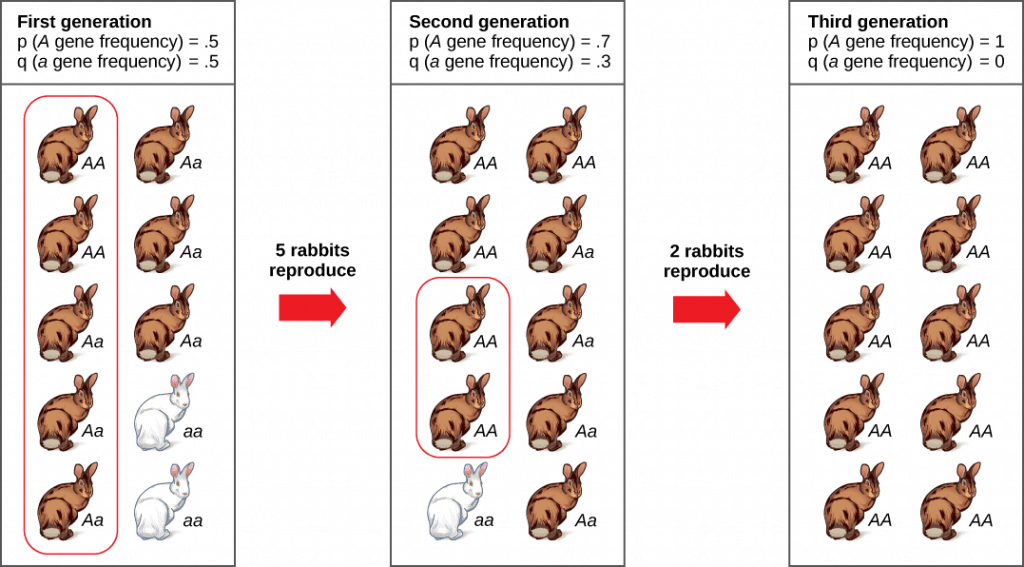What Is A Change In The Genetic Makeup Of A Population Or Species Over Time.
Learning Objective
- Identify, explain, and recognize the consequences of the other mechanisms of evolution (genetic drift, cistron flow, not-random mating, and mutation) in terms of fitness, adaptation, boilerplate phenotype, and genetic diverseness
Biologists organize their thinking about biological processes using evolution as the framework. There are v key mechanisms that crusade a population, a group of interacting organisms of a single species, to exhibit a change in allele frequency from ane generation to the next. These are evolution past: mutation, genetic drift, gene menstruum, non-random mating, and natural selection (previously discussed here). Each machinery of evolution can exist characterized by how it affects fitness, adaptation, the average phenotype of a trait in a population, and the genetic variety of the population.
Mutation generates variation
Evolution by mutation occurs whenever a fault in the Deoxyribonucleic acid occurs in the heritable cells of an organism. In the single-celled asexual organisms, such equally bacterial, the whole cell and its Deoxyribonucleic acid is passed on to the next generation because these organisms reproduce via binary fission. For sexual organisms, mutations are passed to the side by side generation if they occur in the egg or sperm cells used to create offspring. Mutations occur at random in the genome, but mutations of large effect are oft and then bad for the organism that the organism dies as it develops, then mutations of smaller effect or even neutral mutations are theoretically more than common in a population. The variation that is created in a population through the random procedure of mutation is chosen continuing genetic variation, and it must be present for evolution to occur. Mutation is the raw stuff of evolution because it creates new heritable phenotypes, irrespective of fettle or adaptation. Mutation rates are actually pretty low for virtually genes, ranging from 10^-6 for the boilerplate human factor to ten^-10 (per base pair) for the average bacterial gene (from http://bionumbers.hms.harvard.edu/).
Because mutation rates are low relative to population growth in near species, mutation lone doesn't have much of an effect on evolution. Merely mutation combined with one of the other mechanisms of evolution (genetic drift, natural option, non-random mating, and gene period) tin result in meaningful changes in allele frequencies in a population.
Evolution by genetic drift causes changes in populations by chance alone
Evolution by genetic drift occurs when the alleles that make information technology into the next generation in a population are a random sample of the alleles in a population in the electric current generation. By random hazard, not every allele volition make information technology through, and some will be overrepresented while other refuse in frequency regardless of how well those alleles encode for phenotypic suitability to the environment, then sometimes drift reduces the average fettle of a population for its surround. Populations are constantly under the influence of genetic drift. The random drifting of allele frequencies always happens, simply the effect is subtle in larger populations. In these cases, the signal of genetic drift is hands swamped out by the stronger effects of selection or gene menses, so nosotros frequently ignore migrate except in minor or endangered populations, where a random draw of alleles can dramatically alter the population'southward chance of survival in the adjacent generation.

Genetic drift in a population tin lead to the elimination of an allele from a population by chance. In each generation, a random set of individuals reproduces to produce the side by side generation. The frequency of alleles in the next generation is equal to the frequency of alleles amid the individuals reproducing. Practise you think genetic drift would happen more quickly on an island or on the mainland?
Evolution by gene flow (migration) makes two different populations more similar to each other
Two dissimilar populations are oftentimes subject area to unlike selective pressures and genetic drift, so they would exist expected to accept different allele frequencies. When individuals from ane population migrate into a dissimilar population, they bring those different allele frequencies with them. If plenty migration and mating occurs between two populations, then the 2 populations will experience changes in allele frequencies and such that their allele frequencies become like to each other.
Non-random mating results from mate pick
Selecting a mate at random is a pretty risky thought because half of your offspring's genes come up from your mate. Not-random mating is a more common approach in real populations: retrieve about male birds being selected every bit mates by females who choose males for their vivid colouration or beautiful and complex birdsong. At that place is evidence that fish, birds, mice, and primates (including humans) select mates with dissimilar HLA genotypes than themselves. Nosotros humans also tend to mate more often with individuals who resemble united states of america phenotypically (positive phenotypic assortment). Not-random mating with "like" individuals volition shift the genotype frequencies in favour of homozygotes, while not-random mating with "unlike" individuals (negative phenotypic array) creates an over-representation of heterozygotes. These shifts tin occur without changing the proportion of each allele in the population, also called the allele frequency.
Watch this Ted Ed video to review these concepts with an easy way to remember them (simply note that this video does not refer to genetic drift past proper name, but emphasizes that changes in allele frequencies due to chance alone is more than likely to occur in small populations):
Source: https://bioprinciples.biosci.gatech.edu/module-1-evolution/neutral-mechanisms-of-evolution/
Posted by: paddockthadvice.blogspot.com

0 Response to "What Is A Change In The Genetic Makeup Of A Population Or Species Over Time."
Post a Comment